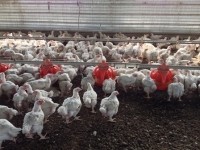New 'game-changing' DSM and Novozymes enzyme allows broilers get more from feed

Initially, the product, which is a microbial muramidase, is being targeted at broiler production.
The enzyme has been shown to consistently improve feed conversion ratios by 4-6 points or 3%, said the partners.
We spoke to two DSM executives - David Blakemore, president of the animal nutrition and health division, and Sebastian Marten, vice president of enzymes and eubiotics - to get the low down on the new product’s functionality and effect.
This is breakthrough innovation, said Blakemore.

“We have a very clear understanding of the science and the mode of action, and its impact in the animal.”
It took about four and a half years to go from conception to launch with Balancius, with the product supported by 40 international trials, said the executives.
“We saw though, very early on, that we had something that was going to matter to the industry, and that gave consistent results in performance, giving us a lot of confidence in what we were doing,” continued Blakemore.
The development mindset, as such, was that there was a need to fast-track the manufacturing, regulatory and commercial side of the product.
It has the potential to improve efficiency for the feed industry through enhanced digestibility, feed utilization and weight gain, said Blakemore.
“We have seen it very consistently in all the trial work we have done when testing the product [that there is] a significant impact on feed conversion and, ultimately, on the weight gain because of the increased nutrient intake in the animal.”
So how does it work?
The enzyme works by breaking down peptidoglycans (PGNs) in bacterial cell debris.
Bacterial debris made up of fragments of cell wall from dead bacteria are released into the intestinal lumen where they may interfere with the intestinal surface. Balancius clears this debris through selectively breaking down PGNs.
“It breaks down bacterial cell debris that builds up on the gut wall, that cell debris limits the ability [of the animal] to absorb nutrients. By breaking down that cell debris you get the impact of improved absorption, and improved nutrient digestibility in the animal,” explained Blakemore.
Marten said enzymes are proteins and, essentially, they stimulate a chemical reaction:
“They hydrolyze the peptidoglycans, which are part of that cell debris. Basically, that cell debris is opened up chemically, and then sugars and amino acids are released into the gut, on the one side, and the dead cell debris [is cleared out], which then unlocks the potential of higher nutrient uptake in the gut of the animal.”
It is the only such technology on the market: “There is no other product, either in DSM’s portfolio, or in the portfolio of any other company, that addresses dead cell debris,” said Marten.
“It is really a unique mode of action,” added Blakemore.
First major enzyme innovation in a decade
Balancius is the first feed enzyme to be launched by the DSM and Novozymes alliance in 10 years, the last major launch for that partnership was RONOZYME ProAct in 2008.
“That product had great success but it was a decade ago and that is part of why we are so excited about this,” said Blakemore.
He stressed the sustainability aspects as well:
“If you look at the population increase that is happening on the planet today, the need to feed people and continue to provide healthy, nutritious, balanced diets, and also the pressure on limited resources, then this is innovation that is coming at the right time. It is great for the industry, great for feed conversion but one that will also have a sustainability impact.”
Indeed, data released by the alliance claimed the use of Balancius in all broiler diets across Latin America and North America would result in a saving of an estimated 4.2m tons of GHG emissions.
Marten said this claim was based on the higher efficiency gains generated by Balancius – less input into the chicken for the same output.
“If you look into the FCR rate improvements [from supplementing diets with the enzyme], you need less feed for the same output and that feed reduction results in certain advantages – you need less agricultural acreage and, therefore, you need less water use, and less pesticide and less nitrogen use. That all leads to the CO2 savings.”
Registration
The product is currently registered in Latin America (Brazil, Argentina, Chile, Colombia, Costa Rica, Mexico), in the US and in APAC (Bangladesh, Pakistan and India). Regulatory approval in Europe, the Middle East and Africa (EMEA) will follow soon - the European Food Safety Authority (EFSA) published a positive opinion on the enzyme in June.
In terms of market introduction, Marten said the plan is to enter different regions across the globe, in a staggered fashion, starting with Latin and North America first, and then other markets over the next 18 months. The alliance is looking at market entry in EMEA mid-2019.
Dosage, feed supplementation
The recommended dosing is between 450g and 750g per metric ton of feed to deliver the documented effect, they said.
The product can be used across the entire lifecycle of the broiler, said Marten.
Ongoing trials are currently addressing the potential for the extension of Balancius into other species.
“We are working hard on that. I guess this product follows the normal track of how DSM thinks about bringing in innovation. We start with poultry as the target species; we develop and focus on the technology and the regulatory [aspects]. Then we will move quickly into swine and there are activities going on today to progress the project there, and then after that, we will evaluate the opportunity space in other species,” said Blakemore.
The enzyme can be supplemented in diets based on any feed raw materials, said Marten.
“We are focusing now on the Brazilian, and the Latin American and US markets so we are particularly looking at its use with soybeans and corn, but it works with all feedstuffs including wheat and rapeseed.”
Enzyme selection
Novozymes is outstanding in the way it screens microbial candidates, and it has the biggest enzyme and research database in the world, noted Marten.
“That screening technology is one of the really competitive advantages of this alliance,” added Blakemore. “We bring the market knowledge [about] the challenges and opportunities in this space and then work together with Novozymes to screen molecules that can [address those needs], we then work together to bring those to market.”













